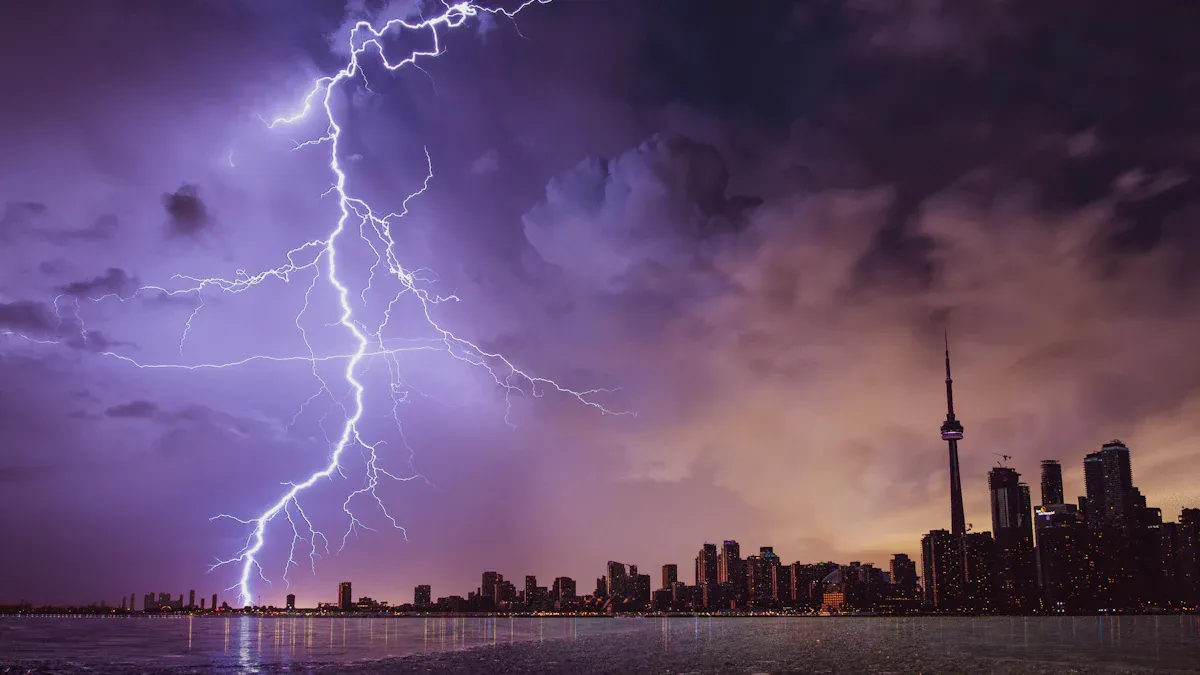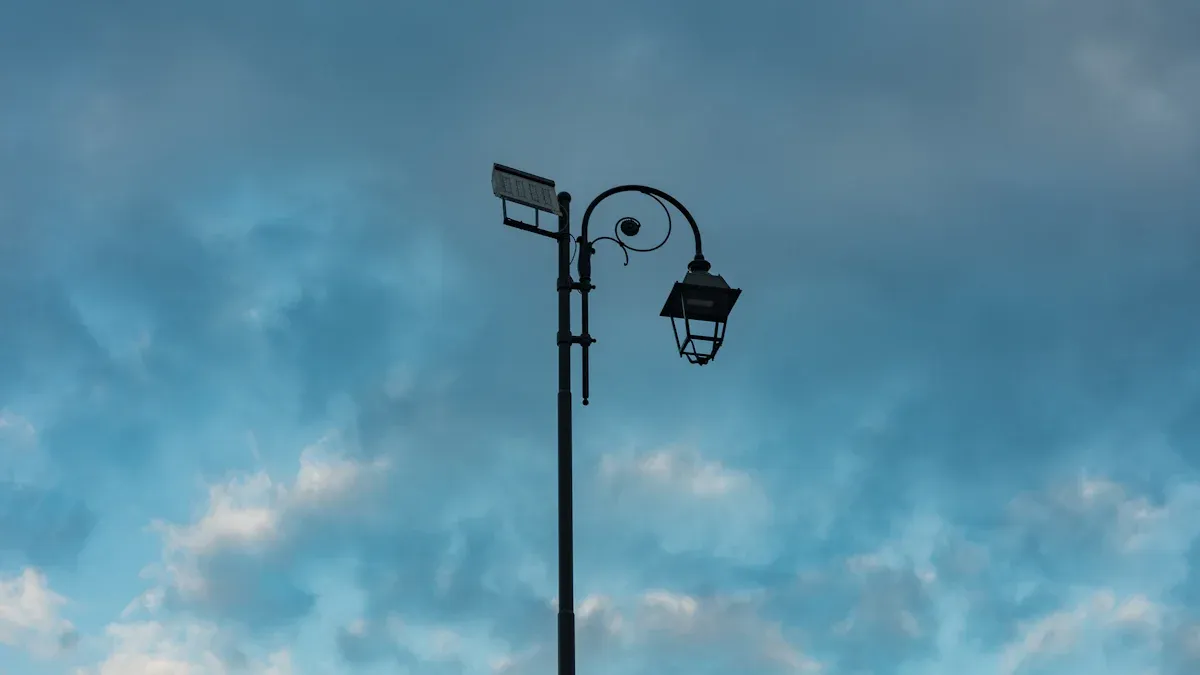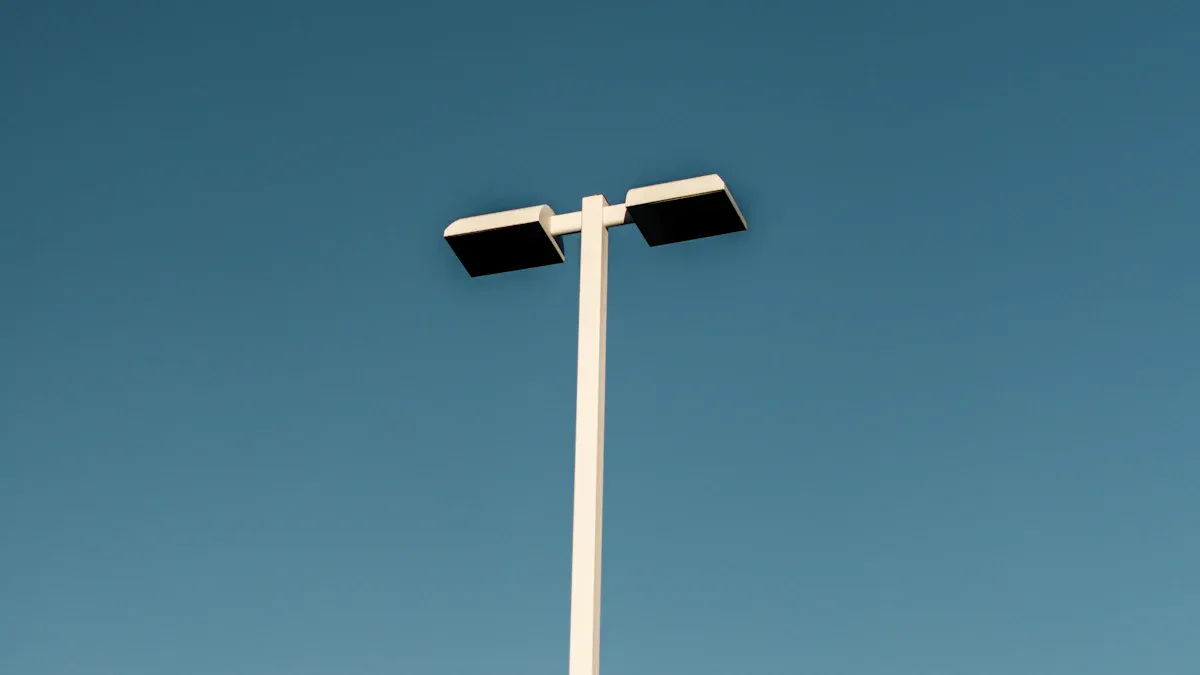Outdoor Light Pole Selection: Weather Resistance, Durability, and Design Considerations

You want the best outdoor light pole selection for your outdoor lighting. You need to think about how weather, durability, and design affect your light poles. Choosing the right poles means you look at material, strength, and style. This guide helps you with pole lights for your Home, Product, or Led Light needs. Use this complete guide when you want to make the right choice. About Us sections often miss these details, but this guide covers what matters for pole lights and light poles.
Key Takeaways
Pick outdoor light poles that can handle your weather. Aluminum does not rust. Steel is good for strong winds.
Use coatings like powder-coating or hot-dip galvanizing. These protect poles from rust and sun. This helps poles last longer.
Make sure your light poles fit the area. Follow local rules for height and placement. This keeps your space bright and safe.
Check your poles often for rust, cracks, or loose parts. Fix problems early to avoid big repairs. This keeps your lights working well.
Plan how you will install the poles. Use strong bases and space them right. This keeps poles steady and gives even light.
Key Factors in Outdoor Light Pole Selection
When you start your outdoor light pole selection, you need to focus on three main things: weather resistance, durability, and design. These factors help you get the best results for outdoor lighting. They also make sure your pole lights last longer and look good in your space.
Weather Resistance
You want your light poles to stand up to rain, wind, and sun. The type of material you choose matters a lot. Aluminum and fiberglass resist rust and corrosion, so they work well in wet or coastal areas. Steel poles offer strength for places with strong winds. Many standards, like ANSI and ASTM, set rules for how light poles should handle tough weather. You should also check the IP rating. A higher IP rating, like IP65, means your pole lights can keep out dust and water. This helps your outdoor lighting work well in all seasons.
Durability
Durability means your light pole can last for years without breaking or rusting. You need to look at the strength of the pole and how it handles things like wind or ice. Aluminum poles are light and do not rust, so they are good for many outdoor spaces. Steel poles are strong and work well in busy or industrial areas. The right foundation keeps your pole lights stable. Following local building codes helps you meet performance expectations and keeps your outdoor lighting safe. When you pick durable materials, you spend less time and money on repairs.
Design
Design is more than just looks. Good design helps your light poles fit in with your landscape and buildings. You want your pole lights to give even light distribution, so every part of your yard or street is bright. Proper placement and height matter for safety and style. Many new led lighting solutions use smart designs to save energy and look modern. When you follow this complete guide, you make sure your outdoor lighting meets both safety and aesthetics. The right design also helps your light poles blend in and improve the feel of your space.
Tip: Use this guide to check each factor before you buy. The right outdoor light pole selection gives you strong, safe, and beautiful lighting for illuminating outdoor spaces.
Weather Resistance in Outdoor Lighting

Materials
Picking the right material is important for outdoor lighting. The material you use helps your light poles handle bad weather. People often pick powder-coated aluminum, steel, brass, or fiberglass. Each one has its own good points.
Powder-coated aluminum does not rust or corrode. It is great for wet or coastal places. Tests show UV powder coatings on aluminum keep over 65% of their shine after 7,000 hours outside. In Florida, these coatings kept more than 95% of their shine after 20 months. This means your pole lights will look nice and last longer.
Steel poles are strong and steady. They are best for windy spots or busy areas. Hot-dip galvanizing puts a thick zinc layer on steel. This helps steel last over 20 years without rusting.
Brass does not corrode and looks classic. You might pick brass for places you want to look fancy.
Fiberglass poles are good for coastal areas. They do not rust and can handle saltwater. Fiberglass is light and strong, so it is easy to use.
Tip: Always pick a material that fits your local weather. This helps your light pole last longer and keeps your lights safe.
Coatings
Coatings protect your light poles from damage. They stop rust, fading, and sun damage. There are different kinds of coatings you can use.
Powder-coated finishes make your pole lights smooth and tough. They stop scratches and block UV rays. UV powder coatings on metal keep colors bright and stop rust. Hot-dip galvanizing covers steel with a thick zinc-iron layer. This protects both the inside and outside of the pole. It can last 25 to 50 years, even in hard weather.
Here is a table that compares two coatings:
Coating Type | Thickness (µm) | Bonding Type | Service Life | Corrosion Rate (µm/year) |
|---|---|---|---|---|
Hot-Dip Galvanizing | 35-99 | Metallurgical zinc-iron | 25-50+ years | 0.1-4.2 (varies by area) |
Electro-Galvanizing | 5-25 | Electrochemical | Shorter, more upkeep | 0.5-5.6 (varies by area) |
You should pick coatings that work for your area. Powder-coated finishes and hot-dip galvanizing help stop rust and make your light pole last longer.
Environmental Fit
Think about your local weather when you pick materials and coatings. Rain, wind, and saltwater can change what you need.
Coastal places need poles that can handle saltwater. Fiberglass and powder-coated aluminum are good choices.
Windy places need strong poles and deep bases. Steel poles with hot-dip galvanizing are best here.
Wet or humid areas need materials that do not rust. Powder-coated finishes and UV coatings help your pole lights last.
Green options use recycled materials and local sources. This helps the environment.
You should also think about where you put your light poles and how tall they are. Good design gives you better light and keeps your system safe. Weatherproof parts and smart controls help your lights work in any weather.
Note: Picking the right material, coating, and design saves you money and stops repairs. Your outdoor lighting will last longer and look nice.
Durability of Street Lighting Poles
Structural Strength
Street lighting poles need to be strong to keep people safe. The strength of a pole depends on a few things. One thing to check is the pole’s gauge. This means how thick the pole is. Thicker poles are stronger and last longer.
You also need to think about wind and ice load ratings. These ratings show how much force a pole can take. Wind speed ratings tell you the highest wind the pole can handle. Tall poles get hit by stronger winds, so they need higher ratings. The Effective Projected Area (EPA) shows how much of the pole catches the wind. You use EPA, wind speed, pole height, and material to pick the right pole.
Wind speed ratings show the most wind a pole can take.
EPA tells you how much of the pole faces the wind.
Wind load uses EPA, wind speed, pole height, and material.
Tall poles need higher wind speed ratings.
The material, like steel or aluminum, changes how strong the pole is.
Engineers test poles in wind tunnels and measure stress.
These steps help make sure your poles are safe.
A good base is important too. The pole needs a strong base to stay up in storms or ice. Always follow local rules and add extra strength for safety. This helps your pole lights stay up in bad weather.
Corrosion Prevention
Corrosion can make your light pole weak and unsafe. You should pick materials and coatings that stop rust. Steel poles often use hot-dip galvanizing. This puts a thick zinc layer on the pole. Aluminum and fiberglass do not rust, so they are good for wet places.
Real-life examples show why stopping corrosion is important. Look at this table:
Location | Number of Poles Inspected | Number of Poles Corroded / Failed | Description of Corrosion Impact |
|---|---|---|---|
72 | 51 | Lots of corrosion problems; 4 poles fell in 3 days; corrosion near the base made poles weak. | |
Massachusetts (Mass Pike) | 4,000 | Many poles badly corroded; some rusted through at the base; 2 poles fell and were removed in 2012; inspections cost a lot of money. |
These stories show that bad corrosion resistance can make poles fall and cost a lot to fix. You should check your poles often, especially near the bottom where water sits. Pick coatings like powder-coating or hot-dip galvanizing to help your poles last longer.
Maintenance
Doing regular maintenance keeps your light poles working well. You should look for rust, cracks, or loose bolts at least once a year. Clean the poles to get rid of dirt and salt that can cause rust. If you see damage, fix it fast to stop bigger problems.
Different materials need different care. Steel poles with good coatings can last over 20 years with simple care. Aluminum and fiberglass need less work because they do not rust. Brass poles look nice but may need polishing to stay shiny. Always follow the maker’s instructions for cleaning and fixing.
Tip: Make a checklist for your maintenance. This helps you find problems early and keep your pole lights safe.
When you use strong materials, stop corrosion, and do regular care, your outdoor lighting lasts longer and stays safe. You also save money because you do not have to fix or replace poles as often.
Design Considerations for Outdoor Lighting

Style
You want your area lighting pole to look nice and fit in. The style should match the buildings and the land around it. Many cities pick designs that show local history or culture. Some lamp posts use shapes or colors from famous places or art. This makes the area feel friendly and helps people feel at home. The table below shows what experts and users like in a good-looking area lighting pole:
Main Category | Sub-categories | Description |
|---|---|---|
Aesthetic Quality | Novel Appearance | Unique designs that show local charm. |
Refined Texture | High-quality materials that look and feel nice. | |
Color Adaptability | Colors that blend with the environment. | |
Functional Quality | Lighting Performance | Even light distribution for better use. |
Safety Performance | Safety features for bad weather. | |
Ease of Maintenance | Easy to repair and keep clean. | |
Environmental Quality | Energy Efficiency | Uses less energy and lasts longer. |
Material Durability | Strong materials that do not need replacing often. | |
Cultural Quality | Interactive Fun | Designs that people enjoy and want to use. |
Distinctive Regional Cultural Characteristics | Shows local culture and history. | |
Cultural Harmony | Matches the style of the area. |
Designers listen to city planners, lighting experts, and local people. They use this feedback to make pole lights that most people like.
Size and Placement
You need to choose the right height and spot for each pole. The height changes how far the light can reach. Short poles are good for paths and gardens. Tall poles work best for parking lots or streets. Put each pole where it lights up the area well. Good placement helps keep people safe and stops dark spots.
Here are some tips for size and placement:
Use tall poles for big spaces.
Space poles evenly for smooth light.
Do not put poles where trees or buildings block the light.
Make sure the light does not shine into windows or onto roads.
Tip: Plan your layout before you put in outdoor lighting. This helps you avoid problems and keeps your area safe.
Compliance
You have to follow local rules when you put in outdoor lighting. Many cities have codes for using light poles. These rules stop glare and keep light off other people’s property. Some towns limit pole height to 30 feet and want metal poles. You may need to use full cutoff fixtures to control extra light. Some places want a lighting plan from an engineer. This plan shows where each pole goes and how much light it gives.
Local codes also ask for safety parts like shields and flat lenses. You may need to lower the lights at night to save energy. Following these rules keeps your lighting safe and legal. It also helps protect the area and your neighbors.
Installation and Maintenance
Installation Tips
You want your outdoor light poles to stand strong for years. Start with a solid plan. Check the soil at your site. Make sure there are no pipes or wires underground. Good soil helps your pole stay stable. Use the right foundation depth and concrete footings. This keeps your pole from tipping in strong winds.
Calculate wind load using the pole’s surface area and local wind speed.
Use the Effective Projected Area (EPA) to choose the right foundation size.
Follow AASHTO guidelines for structural safety.
Pick the right base type. Anchor bases work best for tall or heavy poles, especially in windy places.
Pour enough concrete and let it cure fully before mounting the pole.
Plan your layout so nothing blocks the light.
Tip: Always follow the manufacturer’s instructions for base size, depth, and concrete type. This helps your pole last longer and keeps people safe.
Routine Care
You keep your light poles working well with regular checks. Look for rust, cracks, or loose bolts. Clean the poles to remove dirt and salt. This stops damage and keeps the lights bright. Check the wiring and fixtures for wear. Replace any broken parts right away.
Inspect the base for signs of movement or sinking.
Tighten bolts and check for missing hardware.
Wash the pole with mild soap and water.
Test the lights to make sure they turn on and off.
Light pole maintenance helps you spot problems early. This saves money and keeps your area safe.
Troubleshooting
Sometimes, problems happen even with good care. If a light does not work, check the bulb first. Look at the wiring for damage. If the pole leans or wobbles, inspect the foundation. Cracks or rust at the base mean you need repairs soon. If you see flickering lights, check the connections and replace faulty parts.
Note: Fix small issues quickly. This protects the durability of your lighting system and prevents bigger problems later.
You want the best results from your outdoor light pole selection. This complete guide shows that balancing weather resistance, durability, and design leads to safe and long-lasting outdoor lighting. Use this checklist when you choose:
Check height, size, and material for your needs
Match the pole to your local weather and soil
Pick coatings for extra protection
Make sure the pole fits your style and meets codes
Always review your environment and ask a professional if you need help. This guide helps you make smart choices for every project.
FAQ
What material works best for outdoor light poles?
You should choose aluminum, steel, or fiberglass. Aluminum resists rust. Steel gives you strength. Fiberglass handles salt and moisture. Pick the one that matches your local weather and needs.
How often should you inspect outdoor light poles?
Check your light poles at least once a year. Look for rust, cracks, or loose bolts. Early checks help you find problems before they get worse.
Can you install outdoor light poles by yourself?
You can install small poles for gardens or paths. For tall or heavy poles, hire a professional. This keeps you safe and follows local rules.
How do you prevent corrosion on light poles?
Use poles with powder-coated finishes or hot-dip galvanizing. Clean the poles often. Remove dirt and salt. These steps help stop rust and keep your poles strong.
See Also
How To Select LED Street Light Poles By Material And Height
Essential Installation Tips For Durable And Safe Street Light Poles
Evaluating Lighting Poles To Find The Best Value For Projects
Selecting Street Light Posts Based On Height Material And Setup

